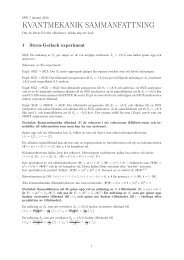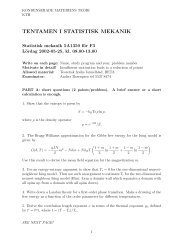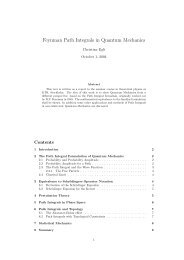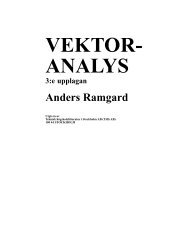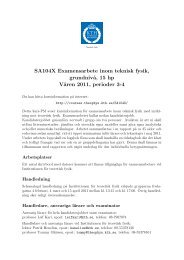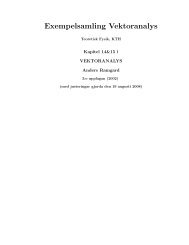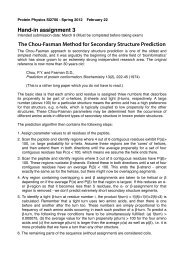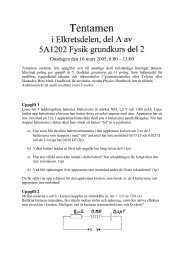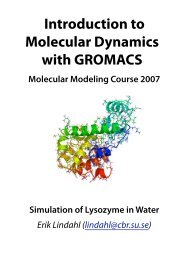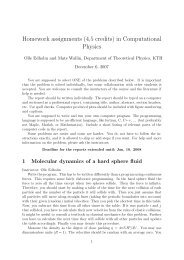[VAR]=Notes on variational calculus
[VAR]=Notes on variational calculus
[VAR]=Notes on variational calculus
Create successful ePaper yourself
Turn your PDF publications into a flip-book with our unique Google optimized e-Paper software.
(since, to increase the area, <strong>on</strong>e needs to stretch the membrane, which increases its<br />
potential energy; see our course book for a more detailed motivati<strong>on</strong>); here and in<br />
the following, subscriped variables indicate differentiati<strong>on</strong>, e.g. u x = ∂u/∂x etc. For<br />
membrane shapes which do not deviate much from the flat membrane u = 0 <strong>on</strong>e can<br />
approximate this functi<strong>on</strong>al by expanding the square root in a power series and <strong>on</strong>ly<br />
taking the leading n<strong>on</strong>-trivial terms, A ≈ ∫ [1+ 1 2 (u2 x+u 2 y)]dxdy. Dropping the irrelevant<br />
c<strong>on</strong>stant term ∫ dxdy we get the following (approximate) energy functi<strong>on</strong>al,<br />
∫<br />
J[u] =<br />
Ω<br />
1<br />
2 ∇u(x)2 d 2 x =<br />
We thus have the following mathematical problem:<br />
∫<br />
Ω<br />
1<br />
2 [u x(x, y) 2 + u y (x, y) 2 ]dxdy. (4)<br />
Problem 3’: Find the real valued functi<strong>on</strong>s u <strong>on</strong> the domain Ω in R 2 which equals to<br />
the functi<strong>on</strong> α <strong>on</strong> ∂Ω and which minimizes the functi<strong>on</strong>al in (4).<br />
The following is a famous variati<strong>on</strong>al problem with a c<strong>on</strong>straint given by a functi<strong>on</strong>al:<br />
Problem 4: Find shape of a homogeneous chain fixed in the two end points in the<br />
earth gravitati<strong>on</strong>al field.<br />
We can model the chain by a functi<strong>on</strong> y(x), x 0 ≤ x ≤ x 1 , where (x i , y i = y(x i ))<br />
for i = 0, 1 the the two fixed end points. The physical principle determining the shape<br />
is again: “the potential energy is a minimum”. We thus need to find a mathematical<br />
expressi<strong>on</strong> for the potential energy: we can think the the chain as a collecti<strong>on</strong> of small<br />
parts labeled by x: each part has the length ds = √ 1 + y ′ (x) 2 dx and mass dm = ρds<br />
where ρ is the mass density (in kg/m) of the chain. The potential energy of such part<br />
is gy(x)dm = gρy(x)ds, and thus the total energy of the chain is<br />
E pot = ρg<br />
∫ x1<br />
x 0<br />
y(x)ds.<br />
It is important to note that the length of the chain is<br />
L =<br />
∫ x1<br />
and when searching for the functi<strong>on</strong> minimizing the potential energy we <strong>on</strong>ly can allow<br />
those where L equals the given length L 0 of the chain:<br />
x 0<br />
Problem 4’: Find the real-valued functi<strong>on</strong> y <strong>on</strong> [x 0 , x 1 ] fixed at the end points, y(x i ) =<br />
y i for i = 0, 1, and minimizing the functi<strong>on</strong>al<br />
J[y] =<br />
∫ x1<br />
ds,<br />
x 0<br />
y(x) √ 1 + y ′ (x) 2 dx (5)<br />
4


![[VAR]=Notes on variational calculus](https://img.yumpu.com/35639168/4/500x640/varnotes-on-variational-calculus.jpg)
